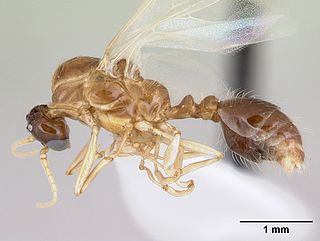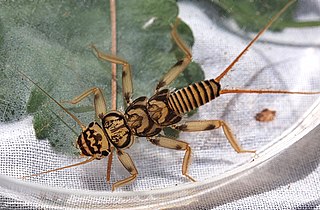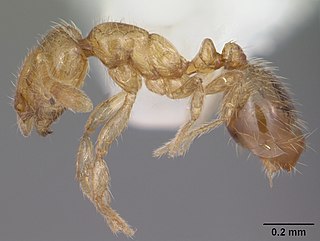Most ants are capable of biting, stinging, and spraying irritant chemicals. However, only relatively few species can harm humans; among which some can cause significant injury or, in rare cases, death. Like wasps, individual ants are capable of stinging multiple times as they do not lose their stingers.

Fire ants are several species of ants in the genus Solenopsis, which includes over 200 species. Solenopsis are stinging ants, and most of their common names reflect this, for example, ginger ants and tropical fire ants. Many of the names shared by this genus are often used interchangeably to refer to other species of ant, such as the term red ant, mostly because of their similar coloration despite not being in the genus Solenopsis. Both Myrmica rubra and Pogonomyrmex barbatus are common examples of non-Solenopsis ants being termed red ants.

The red imported fire ant, also known as the fire ant or RIFA, is a species of ant native to South America. A member of the genus Solenopsis in the subfamily Myrmicinae, it was described by Swiss entomologist Felix Santschi as a variant of S. saevissima in 1916. Its current specific name invicta was given to the ant in 1972 as a separate species. However, the variant and species were the same ant, and the name was preserved due to its wide use. Though South American in origin, the red imported fire ant has been accidentally introduced in Australia, New Zealand, several Asian and Caribbean countries, and the United States. The red imported fire ant is polymorphic, as workers appear in different shapes and sizes. The ant's colours are red and somewhat yellowish with a brown or black gaster, but males are completely black. Red imported fire ants are dominant in altered areas and live in a wide variety of habitats. They can be found in rain forests, disturbed areas, deserts, grasslands, alongside roads and buildings, and in electrical equipment. Colonies form large mounds constructed from soil with no visible entrances because foraging tunnels are built and workers emerge far away from the nest.

Solenopsis daguerrei is a species of parasitic ants native to Argentina and Uruguay . The young queens of the species invade the nests of other species, such as the red imported fire ant (RIFA). This is made possible by the fact that the S. daguerrei queen produces pheromones which are very similar to those produced by the queens of the host species. The young queen finds a queen of the host species and latches onto it, eating the food intended for the host queen and slowly killing it. The S. daguerrei queen then begins laying eggs. These are taken care of by the host ants, sometimes preferentially to their own brood. S. daguerrei only produce winged virgin queens and males. No workers are needed, since these are provided by the host species. The winged ants fly off to mate and invade new colonies.

Nuptial flight is an important phase in the reproduction of most ant, termite, and some bee species. It is also observed in some fly species, such as Rhamphomyia longicauda.

Solenopsis geminata or tropical fire ant is a species of fire ants, described by Fabricius in 1804, in the tribe Solenopsidini; it was originally placed in the Atta genus. This species has a pan-tropical distribution.

Solenopsis saevissima, commonly known in Brazil as formiga de fogo, formiga-vermelha, or formiga-lava-pes, is one of more than 185 species in the genus Solenopsis. It, along with 13 other species, is also a member of the Solenopsis saevissima species group which are popularly known as fire ants.

The red imported fire ant, or simply RIFA, is one of over 280 species in the widespread genus Solenopsis. It is native to South America but it has become both a pest and a health hazard in the southern United States as well as a number of other countries.

Aphaenogaster texana is a species of ant in the family Formicidae.
Panorpa carolinensis is a species of common scorpionfly in the family Panorpidae. It is found in North America.

Solenopsis texana, the thief ant , is a species of ant in the family Formicidae.

Camptonotus carolinensis, the Carolina leaf-roller, is a species of raspy cricket in the family Gryllacrididae. It is found in the eastern United States.
Cyphoderus similis is a species of elongate-bodied springtail in the family Paronellidae. It is myrmecophilic and has been found using Solenopsis invicta in a relationship of phoresis.

Solenopsis tennesseensis is a species of ant in the family Formicidae. It is one of the many species of fire ants.

Acroneuria carolinensis, the Carolina stone, is a species of common stonefly in the family Perlidae. It is found in North America.
Brachypanorpa carolinensis, the short-nosed scorpionfly, is a species of scorpionfly in the family Panorpodidae. It is found in eastern North America.

Solenopsis amblychila is a species of ant native to the southwestern United States. It can withstand very dry conditions but may be found in well watered lawns, and is usually found to nest in soil, under rocks, or under pieces of wood. A notable trait of this species is its pale golden or yellow coloration which makes it commonly mistaken for Solenopsis aurea, which also has a golden coloration. Workers are known to be polymorphic, and contain both major and minor workers in colonies.

Solenopsis abdita is a species of thief ant in the Solenopsis molesta complex, first described in 1989 in Florida. It is native to Florida but may be found in the surrounding states, though this is not confirmed. This species can be hard to differentiate from Solenopsis texana and S. carolinensis, but there are a few minor differences, such as having a longer scape and a wider petiole. Thus, the main method used to distinguish these species primarily uses queens and males, though unfortunately usually only workers are collected, making it difficult to correctly identify this species. S. molesta is known to nest in rotten wood in pine–oak forests, and workers have been collected from leaf litter in said forests.













